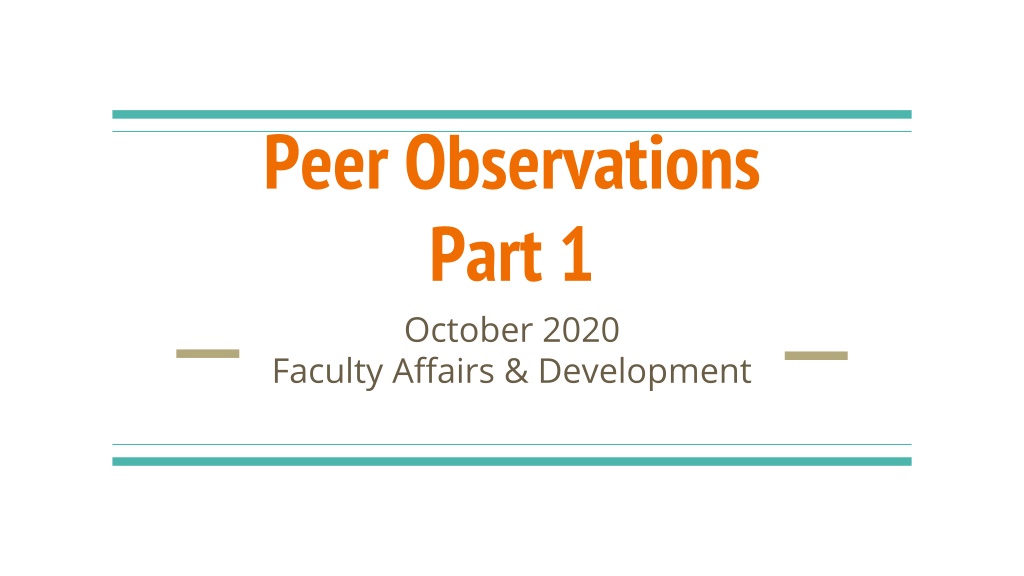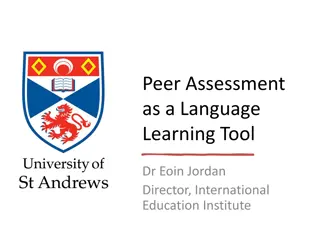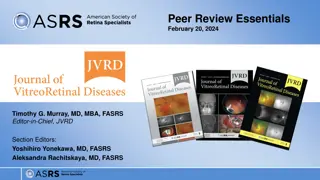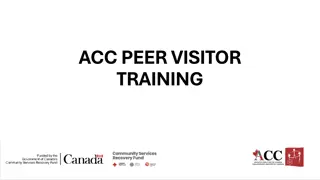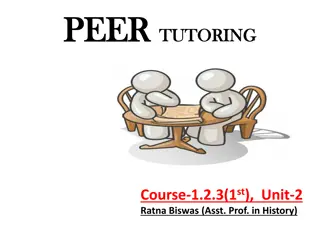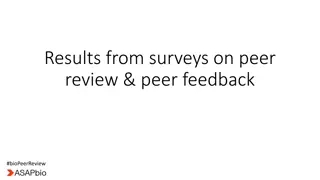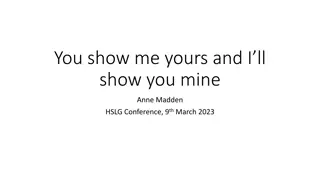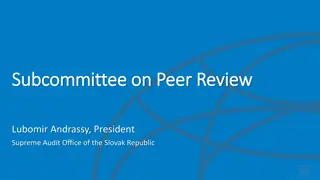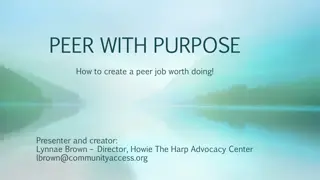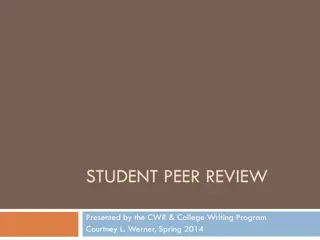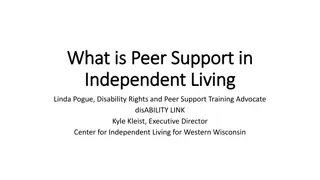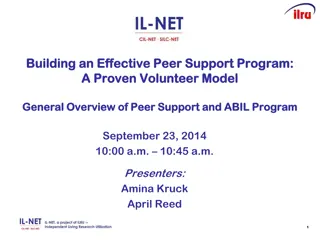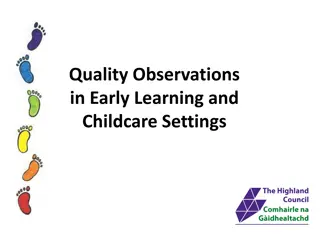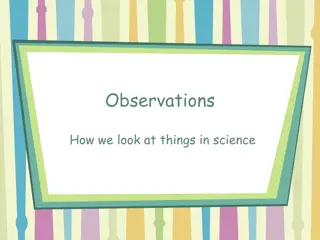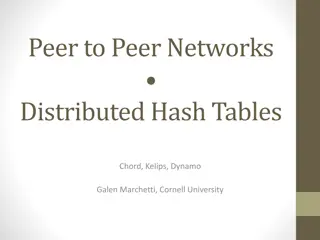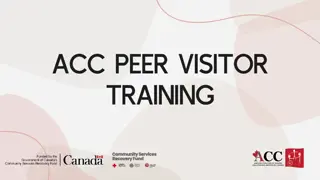Peer Observations Part 1
This collection presents a comprehensive outline of faculty affairs and development initiatives, including peer observations, annual reviews, pre-tenure faculty assessments, and tenure and promotion processes. The guidelines emphasize the importance of peer feedback, training for effective evaluations, and the role of faculty members in the assessment process.
Download Presentation

Please find below an Image/Link to download the presentation.
The content on the website is provided AS IS for your information and personal use only. It may not be sold, licensed, or shared on other websites without obtaining consent from the author. Download presentation by click this link. If you encounter any issues during the download, it is possible that the publisher has removed the file from their server.
E N D
Presentation Transcript
Peer Observations Part 1 October 2020 Faculty Affairs & Development
Faculty Reviews Annual Reviews 1st, 4th, 5th year = materials due end of academic year 2nd, 3rd = materials due mid-academic year Tenure and Promotion Materials due September 1 Promotion Materials due February 1
Peer Observations Initiative 6.1.1.1 American Association of University Professor s Statement of Teaching Evaluation: the primacy of faculty colleague judgments of teaching effectiveness as the first level of review and recommendation, with consistent, transparent, and regular feedback from a faculty member s discipline and dean as key to the evaluation. ...that the faculty member being assessed [has] a meaningful role in the evaluation process,
Pre-tenure Faculty 6.3.1. Pre-tenure faculty members will be observed three times (by three different faculty, within/without the discipline and division) over the course of the academic year for each year leading to the tenure application. A discussion of the observations with the faculty member and action steps will follow with the Dean of Faculty Affairs and Development, and all observations and summaries will be kept on file in the Office of the Dean of Faculty Affairs and Development. 6.3.1.2 Attachments to that document will include the forms used for peer observation of teaching, provided by the Dean of Faculty Affairs and Development, and any summaries and action steps.
Application for Tenure and Promotion 7.3.2.3 Peer observations of the applicant s teaching, supplied by the Dean of Faculty Affairs and Development to the Office of the Vice President for Academic Affairs38 38In partnership with the Office of the Vice President for Academic Affairs, the Dean of Faculty Affairs and Development will organize and provide a program for training and professional development to maximize the equity and effectiveness of peer observation and faculty evaluation. Specifically, training will occur on subjects such as implicit and unconscious bias and categorical thinking, best practices in observing and evaluating instruction, and effective performance feedback. 37Additionally, as observations of an applicant's teaching will not be supplied by the Office of Faculty Affairs and Development for applicants in the fall of 2020, and only one set for applicants in the fall of 2021, a faculty member submitting an application in 2020 and 2021 may use the current language in the Handbook [Section II: 7.2.2.3] and submit "two letters from members of the Faculty who have observed the applicant s teaching (One letter must be written by a member of the applicant s discipline, if possible, while the other may be written by a Faculty member outside the applicant s discipline)."
Tenured Faculty Members, Application for Promotion 7.5.2.3. Two letters from members of the Faculty who have observed the applicant s teaching (One letter must be written by a member of the applicant s discipline, if possible, while the other may be written by a faculty member outside the applicant s discipline)
SNC Model of Peer Observation Purpose: Peer-observations are typically done as a developmental model of professional growth. Honest feedback, critical discussion, and helpful recommendations are part of a formative process. We want to maintain this essential function, while integrating the second essential function of evaluation, the summative process. The peer-observation process is just one component in the evaluation of teaching effectiveness. Other important measures of teaching effectiveness may not lend themselves well to classroom observation.
SNC Model of Peer Observation We have identified 6 major areas of teaching effectiveness and potential indicators that are consistent with SNC values, national models, and peer/aspirant institutions. The indicators are not all-inclusive (there may be additional indicators that you consider) and are not meant to be exhaustive (not every indicator is relevant to every class experience): Content Course Plan; Organization Instructional Strategies Classroom Management; Communication Student Engagement Student Respect and Concern
SNC Model of Peer Observation Each year, a faculty member will have observations and evaluations on 2-3 areas. A faculty member should always be active in choosing at least 1 area, but others may be recommended in consultation with the Discipline Coordinator, the Dean of the division, or the Dean of Faculty Affairs and Development. Starting in 2025, All major areas should be observed and evaluated at least twice (i.e., in two distinct years) prior to applying for tenure and promotion Exceptions for faculty members who are given credit for previous years prior to hire.
SNC Model of Peer Observation Faculty members should meet briefly prior to an observation to discuss classroom goals, provide context, and clarify expectations. Faculty members should also meet after an observation to review the classroom session, receive feedback, and create action steps for growth. Faculty members should take an active role in self-assessment and self- reflection during this process.
SNC Model of Peer Observation: The Process Register for the Teaching Partners Program through the Office of Faculty Development Will assign you to a Teaching Square Division 1, Pre-tenure Faculty A Division 2, Pre-tenure Faculty A Division 1, Post-tenure Faculty B Division 2, Post-tenure Faculty B
SNC Model of Peer Observation: The Process Step 1: Register for the Teaching Partners Program through the Office of Faculty Development Will assign you to a Teaching Square (ideally): Division 1, Pre-tenure Faculty A Division 2, Pre-tenure Faculty A Division 1, Post-tenure Faculty B Division 2, Post-tenure Faculty B 1A may observe 1B, 2B 2A may observe 2B, 1B 1B evaluates 1A, 2A 2B evaluates 2A, 1A
SNC Model of Peer Observation: The Process Step 2: Attend Peer Observation (Part 2) on November 10th Watch brief teaching videos Discuss observations with your square Consider evaluation with the summative form Create hypothetical action steps Plan individualized goals/timeline for the spring semester
SNC Model of Peer Observation: The Process Step 3: Meet in pairs within two weeks prior of the observation session Brief (30 minutes): Explain context of class/course, Share specific goals related to observation, Share materials related to observation Clarify expectations
SNC Model of Peer Observation: The Process Step 4: Observe (Workshop in November will introduce best-practices for a 1- hr observational session; Workshop in January will introduce best-practices for non-F2F formats) Focus on the 6 core areas: Content (we suggest this always be from the discipline) Course Plan; Organization Instructional Strategies Classroom Management; Communication Student Engagement Student Respect and Concern
SNC Model of Peer Observation: The Process Step 5: Meet in pairs within two weeks following the observation session Full (1 hr) session: Review the classroom session Discuss the observations Self-reflect on the strategies, decisions, and intentions in the classroom Assess areas of strengths and areas for improvement
SNC Model of Peer Observation: The Process Step 6: The observing faculty member will complete the summative form as a shared Google Doc. Only the last item should be completed by the observed faculty member.
SNC Model of Peer Observation: The Process Step 6: The observing faculty member will complete the summative form as a shared Google Doc. Observing Faculty member: Complete details regarding the course/timeline Briefly explain relevant context from the pre- observation meeting. For each area, provide an overall impression Not Demonstrated Merits Further Development Satisfactory Well-Demonstrated Outstanding
SNC Model of Peer Observation: The Process Observing Faculty Member (continued): For each area, as support of your overall impression in that area, provide strengths and areas for improvement. Provide overall impressions of teaching effectiveness and next suggested action steps. For the observed faculty member: Reflect on the comments of the observer, and provide a self-assessment of teaching effectiveness, as well as next suggested action steps.
SNC Model of Peer Observation: The Process Final Step: Submit the completed forms to Dean of Faculty Affairs and Development (facaffdev@snc.edu). Dean can upload the form directly into Interfolio for current review process.
Content Instructor statements are accurate according to the standards of the field. Instructor incorporates current research into the course. Instructor identifies a variety of sources, perspectives, and authorities in the field. Instructor uses appropriate examples, metaphors, and analogies. Assessment/evaluation practices are consistent with the depth of material covered. Instructor corrects bias in assigned materials. Instructor uses resources that present both local and global images and perspectives.
Course Plan; Organization Instructor establishes obvious learning goals. Instructor activates students' prior knowledge to allow connections between new learning and what they already know. Performance expectations are clearly defined and understood. Students can reliably prepare for class based on the syllabus. The scope of work/projects is realistic to ensure quality work can be accomplished by a diverse group of students. Instructor monitors and adjusts the classroom schedule based on students' questions, participation and engagement.
Instructional Strategies Instructor is enthusiastic about the subject matter. Instructor uses instructional technology meaningfully. Instructor provides appropriate organizing tools for student comprehension (integrates board, slides, pertinent visuals). Instructor and participants engage in service and experiential learning, or learning through reflection on doing. Instructor monitors and adjusts instruction based on students' questions, participation and engagement. Instructors uses variety of instructional strategies that reflect diverse learning needs.
Classroom Management; Communication Instructor is well-organized and prepared. Instructor addresses students directly when talking. Instructor rephrases or reframes difficult concepts. Instructor appropriately paces activities. Instructor scaffolds content and student exercises with clear transitions and directions. Atmosphere of the classroom is participative. Instructor pays attention to cues of boredom and confusion. Instructor conveys the belief that all students can learn and succeed.
Student Engagement Instructor attempts to broaden the students views. Instructor fosters respect for diverse points of view. Instructor helps students relate content to relevant, real-world applications. Students are interested, active learners (take notes, follow directions, verbally responsive). Students synthesize and draw connections to previous/future class material. The instructor uses positive reinforcement. Instructor creates an equitable and inclusive classroom that respects gender differences, diverse ethnocultural and faith communities, family structures, student abilities/needs and differences in socioeconomic status.
Student Respect and Concern Instructor responds to student questions and comments with appropriate commentary or follow-up. Instructor demonstrates visible rapport with students, addresses students by name Instructor encourages students to build on other s comments and questions. Instructor demonstrates flexibility and adaptability to student needs and questions. Instructor makes content and activities accessible for diverse learners and abilities. Instructor models good listening habits. Instructor conveys openness and warmth and encourages students to interact with others the same way.
